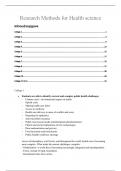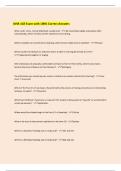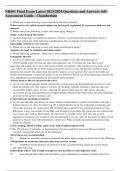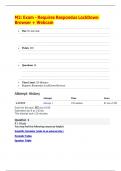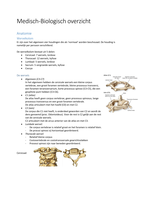Research Methods for Health science
Inhoudsopgave
College 1....................................................................................................................................................................1
College 2....................................................................................................................................................................4
College 3....................................................................................................................................................................9
College 4..................................................................................................................................................................12
College 5..................................................................................................................................................................15
College 6..................................................................................................................................................................17
College 7..................................................................................................................................................................22
College 8..................................................................................................................................................................27
College 9..................................................................................................................................................................30
College 10................................................................................................................................................................36
College 11 & 12.......................................................................................................................................................41
College 1
Students are able to identify current and complex public health challenges
- Climate crisis / environmental impact on health
- Opioid crisis
- Making health care fairer
- Access to medicine
- Health care delivery in areas of conflict and crisis
- Preparing for epidemics
- Anti-microbial resistance
- Public trust (social media misinformation/disinformation)
- Ethical and social implications of new technologies
- Data modernization and privacy
- Food insecurity and food deserts
- Public Health workforce shortage
Across all disciplines, at all levels, and throughout the world, health care is becoming
more complex. What make the current challenges, complex:
- Globalization ‘a world that is becoming increasingly integrated and interdependent’.
- Fuzzy, instead of rigid, boundaries
- Internalized rules drive action
, - Agents within the system change
- Systems are embedded in other systems and co-evolve
Students are able to explain different epistemological stances (e.g., objectivism,
constructivism), theoretical perspectives (e.g., positivism, interpretivism) and the
relationship between them
Epistemology and Theoretical perspectives and the relationship between them
Epistemology = the study of knowledge
- A knowledge of research philosophy will help the researcher to recognize which
designs will work and which will not.
- It can help to clarify issues of research design especially in interdisciplinary teams.
1. Objectivism: we try to strive to truth so objective as possible. Researchers should
strive not to include their own feelings and values. The research is about discovering
this objective truth and presenting fact as truth. It is connected to the theoretical
perspective Positivism, where there is only one reality/truth, and what can be
observed. Reality can be measured. Knowledge can be formulated into laws often
deductive driven and measurement through surveys and data records, together with
statistical analysis
2. Constructivism: meaning is created between interaction, truth and meaning do not
exist in some external world. Meaning is constructed by the researcher not discovered.
Researchers are inherently viewing the world through their frame of reference, there
are multiple realities. It is connected to interpretivism: multiple, contradictory but
equally valid accounts of the world can exist, knowledge is contextual. inductive
driven, multiple data collection methods, such as depth interviews or participation
observation.
,3. Subjectivism: it can differ from constructivism; the meaning is imposed by the subject
on the object subjects do construct meaning, but do so from within collective
unconsciousness, from cultural and religious beliefs. Postmodernism can be taken as
an example of a theoretical perspective linked to subjectivism, Emphasis multiplicity,
ambiguity, ambivalence and fragmentation.
4. Critical inquiry: meta process of investigation and you do not only want to understand
it but also change it. So not only interpret the world but also seek to change it. The
assumption is that ideas are mediated by power relations in society. Also that certain
groups in society are privileged over others and exert an oppressive force on
subordinate groups.
In short:
Objectivism: There is an objective reality ‘out there’.
Constructivism: Subjects construct their own meaning in different ways.
Subjectivism: Meaning is imposed by the subject on the object.
Students can define and give examples of epistemic injustice in health sciences
Epistemic injustice: injustice related to knowledge, exclusion, silencing,
misrepresentation, undervaluing. We still have the tendency to hear not al voices that
are important and to disregards local and indigenous knowledge and refuses to learn
from people often deemed to be lesser.
Students can reflect on their own positionality
Exploring your own theory of knowledge and theoretical perspectives is important
because it influences your choices.
Students are able to formulate an objective and research questions
Objective and research questions: in the beginning of the research process to the
research topic. Research process: literature + problems & questions of the workplace
, or community setting (research agenda’s) research topic (think about the
knowledge gap you’re aiming to fill) objective & research question (contributes to
understanding and/or problem solving) with an external and internal objective
Methodology.
It can be formed by literature or problems & questions of the workplace or community
setting. The first one is theoretical oriented and the other practical. The most important
one is the research gap, so what can de study contribute to the field, what is the niche.
You want to avoid:
- Too big
- Too trivial
- Lack in resources
- Dependent on the completion of another project
- Unethical
-
You want to interpret:
- Useful (relevant)
- Realistic
- Feasible
- Clear
- Informative
Some examples shot to get to a research topic:
- Own previous research
- Experiences from the fieldwork
- Donor informed.
- Patient organization informed.
- Interviewing experts and develop new research agenda.
And then from topic to the objective: what can I contribute to the understanding or
solving the topic, so understanding or it has a practical relevance. It has to be
informative, useful, realistic, feasible and clear.
There are two objectives.
1) external objective = contribution of your research project to solution of the
problem / what results can be expected
2) internal objective = in this study we investigate the effect…= The way in which this
will be done / the insights, information, knowledge needed and is very similar to
your research question
There can be multiple research questions but mostly one objective. They are not set in
stone and establish boundaries. Example: ‘is alcohol abuse at work a problem?’. So
this is a yes/no problem and what do we mean by work? So the question still needs a
lot of work cause it need to be open and certain words to be specified.
College 2
Students are able to explain inductive and deductive reasoning
Inhoudsopgave
College 1....................................................................................................................................................................1
College 2....................................................................................................................................................................4
College 3....................................................................................................................................................................9
College 4..................................................................................................................................................................12
College 5..................................................................................................................................................................15
College 6..................................................................................................................................................................17
College 7..................................................................................................................................................................22
College 8..................................................................................................................................................................27
College 9..................................................................................................................................................................30
College 10................................................................................................................................................................36
College 11 & 12.......................................................................................................................................................41
College 1
Students are able to identify current and complex public health challenges
- Climate crisis / environmental impact on health
- Opioid crisis
- Making health care fairer
- Access to medicine
- Health care delivery in areas of conflict and crisis
- Preparing for epidemics
- Anti-microbial resistance
- Public trust (social media misinformation/disinformation)
- Ethical and social implications of new technologies
- Data modernization and privacy
- Food insecurity and food deserts
- Public Health workforce shortage
Across all disciplines, at all levels, and throughout the world, health care is becoming
more complex. What make the current challenges, complex:
- Globalization ‘a world that is becoming increasingly integrated and interdependent’.
- Fuzzy, instead of rigid, boundaries
- Internalized rules drive action
, - Agents within the system change
- Systems are embedded in other systems and co-evolve
Students are able to explain different epistemological stances (e.g., objectivism,
constructivism), theoretical perspectives (e.g., positivism, interpretivism) and the
relationship between them
Epistemology and Theoretical perspectives and the relationship between them
Epistemology = the study of knowledge
- A knowledge of research philosophy will help the researcher to recognize which
designs will work and which will not.
- It can help to clarify issues of research design especially in interdisciplinary teams.
1. Objectivism: we try to strive to truth so objective as possible. Researchers should
strive not to include their own feelings and values. The research is about discovering
this objective truth and presenting fact as truth. It is connected to the theoretical
perspective Positivism, where there is only one reality/truth, and what can be
observed. Reality can be measured. Knowledge can be formulated into laws often
deductive driven and measurement through surveys and data records, together with
statistical analysis
2. Constructivism: meaning is created between interaction, truth and meaning do not
exist in some external world. Meaning is constructed by the researcher not discovered.
Researchers are inherently viewing the world through their frame of reference, there
are multiple realities. It is connected to interpretivism: multiple, contradictory but
equally valid accounts of the world can exist, knowledge is contextual. inductive
driven, multiple data collection methods, such as depth interviews or participation
observation.
,3. Subjectivism: it can differ from constructivism; the meaning is imposed by the subject
on the object subjects do construct meaning, but do so from within collective
unconsciousness, from cultural and religious beliefs. Postmodernism can be taken as
an example of a theoretical perspective linked to subjectivism, Emphasis multiplicity,
ambiguity, ambivalence and fragmentation.
4. Critical inquiry: meta process of investigation and you do not only want to understand
it but also change it. So not only interpret the world but also seek to change it. The
assumption is that ideas are mediated by power relations in society. Also that certain
groups in society are privileged over others and exert an oppressive force on
subordinate groups.
In short:
Objectivism: There is an objective reality ‘out there’.
Constructivism: Subjects construct their own meaning in different ways.
Subjectivism: Meaning is imposed by the subject on the object.
Students can define and give examples of epistemic injustice in health sciences
Epistemic injustice: injustice related to knowledge, exclusion, silencing,
misrepresentation, undervaluing. We still have the tendency to hear not al voices that
are important and to disregards local and indigenous knowledge and refuses to learn
from people often deemed to be lesser.
Students can reflect on their own positionality
Exploring your own theory of knowledge and theoretical perspectives is important
because it influences your choices.
Students are able to formulate an objective and research questions
Objective and research questions: in the beginning of the research process to the
research topic. Research process: literature + problems & questions of the workplace
, or community setting (research agenda’s) research topic (think about the
knowledge gap you’re aiming to fill) objective & research question (contributes to
understanding and/or problem solving) with an external and internal objective
Methodology.
It can be formed by literature or problems & questions of the workplace or community
setting. The first one is theoretical oriented and the other practical. The most important
one is the research gap, so what can de study contribute to the field, what is the niche.
You want to avoid:
- Too big
- Too trivial
- Lack in resources
- Dependent on the completion of another project
- Unethical
-
You want to interpret:
- Useful (relevant)
- Realistic
- Feasible
- Clear
- Informative
Some examples shot to get to a research topic:
- Own previous research
- Experiences from the fieldwork
- Donor informed.
- Patient organization informed.
- Interviewing experts and develop new research agenda.
And then from topic to the objective: what can I contribute to the understanding or
solving the topic, so understanding or it has a practical relevance. It has to be
informative, useful, realistic, feasible and clear.
There are two objectives.
1) external objective = contribution of your research project to solution of the
problem / what results can be expected
2) internal objective = in this study we investigate the effect…= The way in which this
will be done / the insights, information, knowledge needed and is very similar to
your research question
There can be multiple research questions but mostly one objective. They are not set in
stone and establish boundaries. Example: ‘is alcohol abuse at work a problem?’. So
this is a yes/no problem and what do we mean by work? So the question still needs a
lot of work cause it need to be open and certain words to be specified.
College 2
Students are able to explain inductive and deductive reasoning

